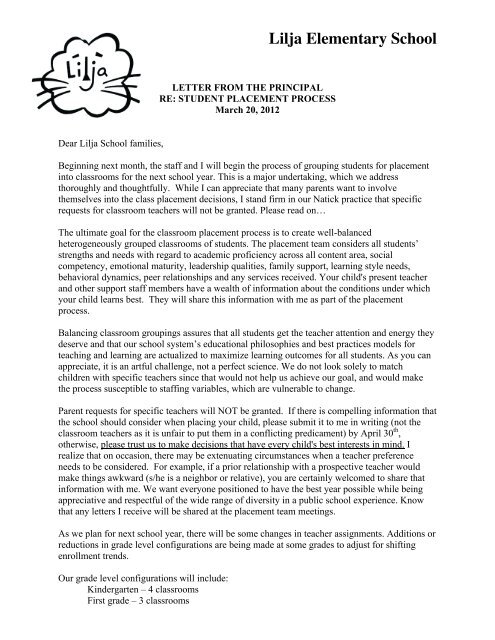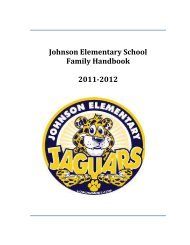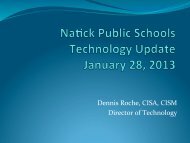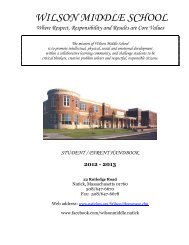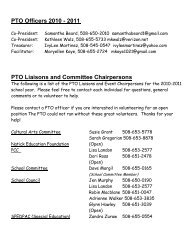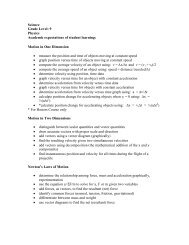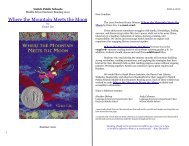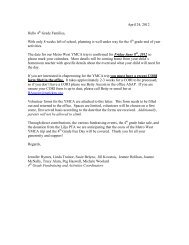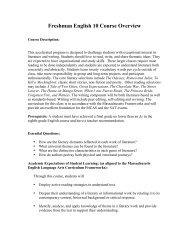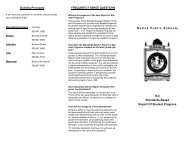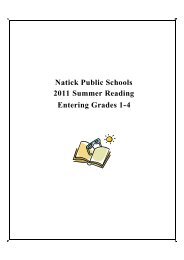Placement Letter to Parents - Natick Public Schools
Placement Letter to Parents - Natick Public Schools
Placement Letter to Parents - Natick Public Schools
Create successful ePaper yourself
Turn your PDF publications into a flip-book with our unique Google optimized e-Paper software.
Lilja Elementary School<br />
LETTER FROM THE PRINCIPAL<br />
RE: STUDENT PLACEMENT PROCESS<br />
March 20, 2012<br />
Dear Lilja School families,<br />
Beginning next month, the staff and I will begin the process of grouping students for placement<br />
in<strong>to</strong> classrooms for the next school year. This is a major undertaking, which we address<br />
thoroughly and thoughtfully. While I can appreciate that many parents want <strong>to</strong> involve<br />
themselves in<strong>to</strong> the class placement decisions, I stand firm in our <strong>Natick</strong> practice that specific<br />
requests for classroom teachers will not be granted. Please read on…<br />
The ultimate goal for the classroom placement process is <strong>to</strong> create well-balanced<br />
heterogeneously grouped classrooms of students. The placement team considers all students’<br />
strengths and needs with regard <strong>to</strong> academic proficiency across all content area, social<br />
competency, emotional maturity, leadership qualities, family support, learning style needs,<br />
behavioral dynamics, peer relationships and any services received. Your child's present teacher<br />
and other support staff members have a wealth of information about the conditions under which<br />
your child learns best. They will share this information with me as part of the placement<br />
process.<br />
Balancing classroom groupings assures that all students get the teacher attention and energy they<br />
deserve and that our school system’s educational philosophies and best practices models for<br />
teaching and learning are actualized <strong>to</strong> maximize learning outcomes for all students. As you can<br />
appreciate, it is an artful challenge, not a perfect science. We do not look solely <strong>to</strong> match<br />
children with specific teachers since that would not help us achieve our goal, and would make<br />
the process susceptible <strong>to</strong> staffing variables, which are vulnerable <strong>to</strong> change.<br />
Parent requests for specific teachers will NOT be granted. If there is compelling information that<br />
the school should consider when placing your child, please submit it <strong>to</strong> me in writing (not the<br />
classroom teachers as it is unfair <strong>to</strong> put them in a conflicting predicament) by April 30 th ,<br />
otherwise, please trust us <strong>to</strong> make decisions that have every child's best interests in mind. I<br />
realize that on occasion, there may be extenuating circumstances when a teacher preference<br />
needs <strong>to</strong> be considered. For example, if a prior relationship with a prospective teacher would<br />
make things awkward (s/he is a neighbor or relative), you are certainly welcomed <strong>to</strong> share that<br />
information with me. We want everyone positioned <strong>to</strong> have the best year possible while being<br />
appreciative and respectful of the wide range of diversity in a public school experience. Know<br />
that any letters I receive will be shared at the placement team meetings.<br />
As we plan for next school year, there will be some changes in teacher assignments. Additions or<br />
reductions in grade level configurations are being made at some grades <strong>to</strong> adjust for shifting<br />
enrollment trends.<br />
Our grade level configurations will include:<br />
Kindergarten – 4 classrooms<br />
First grade – 3 classrooms
Grade 1-2 multiage configuration – 2 classrooms (** mixed grade classrooms - see<br />
below)<br />
Second grade – 3 classrooms (* including one teacher who will loop from grade 2 <strong>to</strong> 3<br />
with her class at the end of next school year – see below)<br />
Third grade – 3 classrooms<br />
Grade 4 – 4 classrooms<br />
Lilja School is adding two additional classrooms <strong>to</strong> reduce class size at kindergarten and first<br />
grade levels (our current kindergarten and next year’s kindergarten numbers warrant four<br />
classrooms <strong>to</strong> maintain class size under 25) and thus we will have a <strong>to</strong>tal of 19 general education<br />
classrooms. In addition, we will continue <strong>to</strong> integrate students from our ACCESS Program,<br />
which provides specialized programming. We are reducing the present two ACCESS classrooms<br />
<strong>to</strong> one classroom at Lilja for next year. None of our current students will be displaced (except<br />
those graduating <strong>to</strong> the middle school level). An additional ACCESS classroom will be added at<br />
Ben Hem <strong>to</strong> accommodate for the needs of next year’s kindergarten level students who need<br />
specialized programming.<br />
• (*) Looping is an educational practice in which a single graded class of children stays<br />
with a teacher for two years or grade levels. The children and the teacher remain <strong>to</strong>gether<br />
as the class is promoted. For students, the benefits of looping include reduced<br />
apprehension at starting a new school year, increased continuity, and more in-depth<br />
relationships with teacher and with peers. For teachers, the benefits of looping consist of<br />
becoming familiar with broader developmental stages of children, and working with<br />
students and parents for longer periods of time. The long-term relationships established<br />
through looping have been shown <strong>to</strong> support student learning.<br />
• (**) In 1997, Lilja initiated multi-age classrooms in addition <strong>to</strong> single grade classrooms.<br />
In our present model, there are (2) classrooms that are comprised half of first graders and<br />
half of second graders. Students in these classrooms cycle up with the same teacher from<br />
first <strong>to</strong> second grade, remaining with the same teacher for a two-year period. During this<br />
two-year cycle, students in the multi-age classrooms receive instruction in the same<br />
curriculum <strong>to</strong>pics and areas of study that occur in single grade classrooms. Our multiage<br />
classrooms afford broader age-range and developmental diversity. Students receive all<br />
content area learning in an aged mixed model, with the exception of math where students<br />
are grouped by grade level for sequential instruction.<br />
If for any reason, you think your child wouldn’t do well with the same teacher for two<br />
consecutive years, please alert me <strong>to</strong> opt them out of the mix for a multiage and/or looping<br />
classroom configurations.<br />
Our students will have an opportunity <strong>to</strong> meet their next year's teacher and classmates on "Sneak<br />
Preview Day" at the end of the school year. <strong>Parents</strong> will be notified of their child's placement on<br />
the final report card.<br />
Thank you for working with us <strong>to</strong> support the learning of all our Lilja School students.<br />
Sincerely,<br />
Barbara Brown, Ed.D.<br />
Principal


